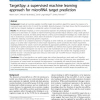Free Online Productivity Tools
i2Speak
i2Symbol
i2OCR
iTex2Img
iWeb2Print
iWeb2Shot
i2Type
iPdf2Split
iPdf2Merge
i2Bopomofo
i2Arabic
i2Style
i2Image
i2PDF
iLatex2Rtf
Sci2ools
BMCBI
2010
2010
TargetSpy: a supervised machine learning approach for microRNA target prediction
Background: Virtually all currently available microRNA target site prediction algorithms require the presence of a (conserved) seed match to the 5' end of the microRNA. Recently however, it has been shown that this requirement might be too stringent, leading to a substantial number of missed target sites. Results: We developed TargetSpy, a novel computational approach for predicting target sites regardless of the presence of a seed match. It is based on machine learning and automatic feature selection using a wide spectrum of compositional, structural, and base pairing features covering current biological knowledge. Our model does not rely on evolutionary conservation, which allows the detection of species-specific interactions and makes TargetSpy suitable for analyzing unconserved genomic sequences. In order to allow for an unbiased comparison of TargetSpy to other methods, we classified all algorithms into three groups: I) no seed match requirement, II) seed match requirement, ...
| Added | 08 Dec 2010 |
| Updated | 08 Dec 2010 |
| Type | Journal |
| Year | 2010 |
| Where | BMCBI |
| Authors | Martin Sturm, Michael Hackenberg, David Langenberger, Dmitrij Frishman |
Comments (0)

